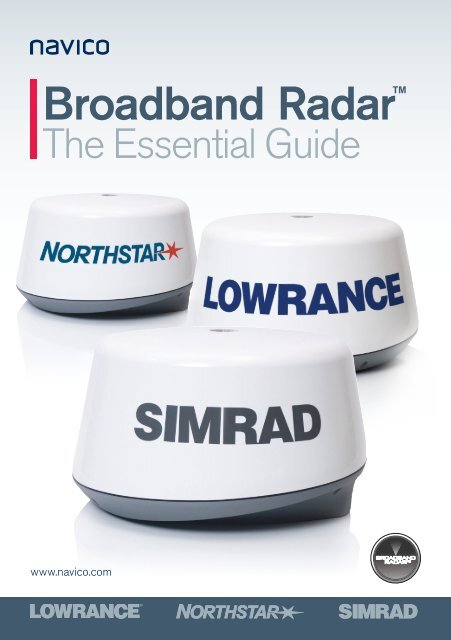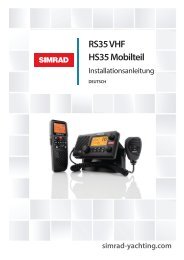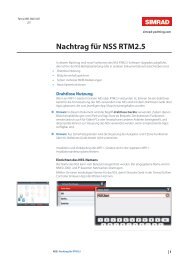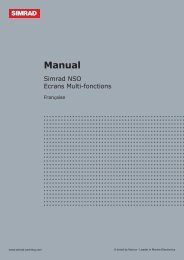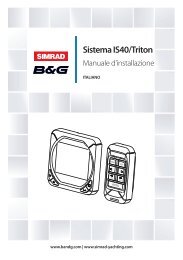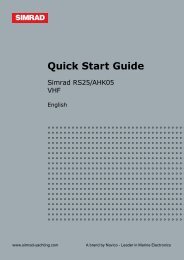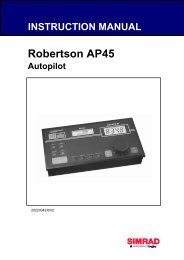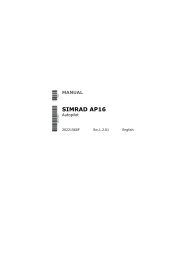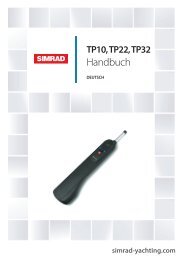Broadband Radar™ - Simrad Yachting
Broadband Radar™ - Simrad Yachting
Broadband Radar™ - Simrad Yachting
Create successful ePaper yourself
Turn your PDF publications into a flip-book with our unique Google optimized e-Paper software.
<strong>Broadband</strong> Radar <br />
The Essential Guide<br />
www.navico.com
<strong>Broadband</strong> Radar <br />
A New Revolution in Radar<br />
The most significant radar<br />
breakthrough since 1940<br />
• Crystal clear image<br />
Miss none of your immediate surroundings.<br />
Fantastic for tight maneuvers in marinas or in<br />
conditions of limited visibility.<br />
• InstantOn<br />
Solid-state technology produces an immediate,<br />
accurate on-screen image.<br />
• Low power consumption<br />
<strong>Broadband</strong> Radar requires very little power: ideal<br />
for all types and size of boat.<br />
• Extremely low emissions<br />
This safest of radars means it can be mounted<br />
anywhere. <strong>Broadband</strong> Radar has fewer emissions<br />
a mobile phone.<br />
• Quick installation<br />
No reason to open the dome, no tune or zero mile<br />
adjustment, and best of all – no radar-licensed<br />
technician required.<br />
• Automatic clarity<br />
Proven Auto Harbor and Offshore modes<br />
completely optimise the radar image – even on<br />
our shortest range of 200 feet. Just steer.<br />
www.lowrance.com | www.northstarnav.com | www.simrad-yachting.com
Navico - Leader in Marine Electronics<br />
Navico is the parent organization to five of the world’s leading marine leisure electronics brands: B&G, Eagle,<br />
Lowrance, Northstar and <strong>Simrad</strong> <strong>Yachting</strong>. Together these brands develop and manufacture the full range of<br />
navigation and communications equipment used by craft in the leisure and coastal commercial sectors.<br />
Formed in 2007 by the bringing together of <strong>Simrad</strong><br />
<strong>Yachting</strong>, Lowrance Electronics and the marine<br />
division of Brunswick New Technologies, Navico<br />
has a truly global reach and offers an unrivalled<br />
breadth of choice to suit every requirement and<br />
budget, whether it is in chartplotters and echosounders<br />
for leisure boaters, racing instrumentation<br />
for grand-prix competitors, or fully integrated<br />
navigation systems for the largest luxury yachts.<br />
As a research-driven organization Navico maintains<br />
center of technological excellence around the<br />
world, including development facilities for GPS and<br />
echo-sounder products in the USA, autosteering<br />
in Norway, instrumentation in the UK, and radar<br />
in New Zealand. The development of <strong>Broadband</strong><br />
Radar is an excellent example of the long-term<br />
approach that Navico takes to ensuring that it<br />
remains at the forefront of marine electronics.<br />
Over five years of R&D and the application of<br />
substantial funding, including a grant from the<br />
New Zealand government, went in to achieving this<br />
revolutionary advance in marine navigation, but the<br />
enthusiastic response to its introduction from the<br />
<strong>Broadband</strong> Radar Engineers in New Zealand<br />
Pyramidal foam inside an anechoic chamber<br />
to eliminate internal signal reflections when<br />
testing the BR24<br />
Navico - Leader in Marine Electronics 3<br />
worldwide boating community demonstrates the<br />
benefits of investing time and resources in seeking<br />
radical new solutions to the challenges of the<br />
marine environment.<br />
Yachtsmen, anglers and professional mariners can<br />
expect to see a steady flow of similarly exciting<br />
new products from the Navico brands in the coming<br />
years. With a commitment to ever-enhanced<br />
“Over five years of R&D<br />
went in to achieving<br />
this revolutionary<br />
advance in marine<br />
navigation”<br />
performance, ease of operability and seamless<br />
systems integration, Navico will continue to set<br />
the pace in innovation for the marine electronics<br />
industry for the foreseeable future.<br />
The BR24 Radome has undergone demanding<br />
waterproof testing
4<br />
How does it work?<br />
<strong>Broadband</strong> Radar compared to conventional pulse radar<br />
Conventional pulse radar uses a magnetron<br />
to generate a pulsed microwave signal that is<br />
transmitted from the rotating radar antenna.<br />
This “bang” of microwave energy is reflected<br />
off targets that it hits and returns to the radar,<br />
the time it takes determines the range and<br />
bearing.<br />
This type of radar transmission is, in layman’s<br />
terms like shouting loudly in one direction<br />
and then listening to see if you hear an echo,<br />
turning and then repeating.<br />
<strong>Broadband</strong> Radar uses a different type of<br />
technology, allowing the radar to send out a<br />
continuous radar signal, with a changing tone<br />
or frequency, at a very much lower power<br />
and listen for the change in that signal, also<br />
continuously. This is more like whispering<br />
continuously and listening at the same time<br />
for the echo, made possible in the radar by<br />
using two antennas, one whispering and one<br />
listening.<br />
The change in the tone of the transmitted<br />
radar signal determines the time taken for the<br />
signal to reach the target and return. This time<br />
determines the range and the bearing.<br />
There is a distinct advantage in sending out a<br />
much lower signal, the distortion in a normal<br />
radar transmission, that is likened to a shout<br />
gets distorted at close ranges, this is often<br />
referred to as “main bang” interference and<br />
appears on the screen as a sunburst in the<br />
center of the screen. At short ranges this<br />
noise covers up any close in targets, reducing<br />
the effectiveness of the radar at short range.<br />
Many types of radar suppress this pulse and<br />
hide the noise; this also hides any short-range<br />
targets effectively blinding the radar to close<br />
by targets.<br />
With the <strong>Broadband</strong> Radar only sending out<br />
a “whisper” the noise and distortion is just not<br />
there, hence there is no noise in the center of<br />
the screen and also no need for noise or main<br />
bang suppression. The benefit of this is that<br />
close up targets are not lost or hidden, with<br />
the radar able to show targets right up until<br />
they are alongside the boat. This short-range<br />
performance has never before been seen.<br />
Conventional radars emit a pulse, and this<br />
pulse varies in length depending on the range.<br />
This pulse length determines the ability of<br />
the conventional radar to distinguish between<br />
close targets on a similar bearing. Usually this<br />
can be as short as 90ft at short ranges and<br />
up to 500ft at longer ranges. The <strong>Broadband</strong><br />
Radar, using the continuously transmitted<br />
signal, is able to see targets as close as 6ft<br />
from the dome on the shortest scale and<br />
separate targets 30ft apart in range on the<br />
scales used for navigation.<br />
This short-range performance is also<br />
enhanced with the minimum range scales now<br />
going beyond the conventional 1/8 th of a mile<br />
range down to 1/32 nd of a mile. To help with<br />
the comprehension of these shorter ranges<br />
the radar switches to feet for the shortest<br />
ranges, you can display 400ft, 300ft and<br />
200ft, with range rings of only 100ft.<br />
The dual microwave stripline<br />
arrays inside of the antenna<br />
dome allow continuous<br />
transmission and reception,<br />
unlike conventional radar<br />
that only has one antenna<br />
used for both.<br />
The Essential Guide to <strong>Broadband</strong> Radar
The outcome of this whisper technology is,<br />
better short range detection, better visibility<br />
of close in targets and better target range<br />
resolution in comparison to conventional<br />
radar.<br />
The better target range resolution also helps<br />
in reducing sea clutter. This is due to the<br />
radar being able to detect different targets<br />
Greg Konig, Vice-President for Navico’s Product<br />
Line was asked at a Press lunch if he could explain<br />
how <strong>Broadband</strong> Radar works<br />
“in Layman’s terms”. Konig<br />
obviously did not want<br />
to launch into a lengthy<br />
discourse over salad and<br />
sandwiches. “In Layman’s<br />
terms” he said, pausing for<br />
effect “....it’s magic!”<br />
With help from Konig and<br />
other folks at Navico, we’ll<br />
now try to explain how<br />
<strong>Broadband</strong> Radar works<br />
and how it differs from<br />
conventional Pulse Radar<br />
Conventional or pulse radar<br />
is generated by a magnetron,<br />
which has been compared to a<br />
valve opening and closing to<br />
release pulses of energy.<br />
In layman’s terms: Imagine<br />
you are standing blindfolded<br />
near a house. You holler “hello!” and then listen<br />
to hear the echo. Let’s assume you are changing<br />
direction like a rotating radome as you continue to<br />
call “hello!” and listen again. You holler, pause, listen;<br />
holler, pause, listen. Your sense of hearing is more<br />
finely tunes than most, and the echoes tell you that<br />
there is an irregular object nearby in a particular<br />
direction at a specific distance.<br />
How does it work?<br />
at small range difference, much better than<br />
conventional radar. Radar echoes from waves<br />
are much easier to filter out as the returns are<br />
smaller, rather than several waves returning a<br />
single large echo that displays as one target.<br />
This helps keep a much clearer display and<br />
enables the detection of smaller floats or<br />
buoys in the water.<br />
<strong>Broadband</strong> Radar is a marketing name for what<br />
engineers call frequency-modulated continuouswave<br />
(FMCW) radar. The word “broadband”<br />
nowadays is associated with good computer<br />
connectivity; Navico justified use of this term<br />
because its radar emits signals along a broad range<br />
of frequencies. It does this without a magnetron,<br />
instead using two solid-state amplifiers: one to<br />
transmit waves at continuously<br />
increasing frequencies, the<br />
other to simultaneously<br />
receive their echoes.<br />
Now, Mr. Layman, you are<br />
standing near the same<br />
house, not hollering. You are<br />
whispering, “do, re, me, fa, so,<br />
la, ti, do; do, re, me, fa, so, la,<br />
ti, do,” etc. As you rotate and<br />
whisper, you listen for echoes,<br />
with an ear for nuance. You<br />
don’t pause; you whisper<br />
and listen simultaneously.<br />
You clock the echo from each<br />
discreet note and use these<br />
streaming time-stamps to<br />
build a mental picture of a<br />
building with a tree in front of<br />
it, but not touching.<br />
“You are able to match what<br />
you see on the screen to<br />
reality quicker that you ordinarily could. It also<br />
eliminates sea clutter and rain clutter about five<br />
times better than your traditional radar, and you<br />
don’t have to tune the radar to get the signals to pop<br />
out from the noise” Konig said.<br />
Excerpts from “Radar Love” in Passage Maker<br />
Magazine, courtesy of Peter Swanson<br />
5
6<br />
<strong>Broadband</strong> and FMCW explained<br />
Introducing a revolutionary new radar system unlike anything else on the recreational boating market.<br />
Utilizing solid-state technology, this breakthrough radar solution provides superior target detection<br />
and separation, ease of operation, and a new level of navigational safety to a wide range of boats.<br />
The exclusive technology and performance characteristics of <strong>Broadband</strong> Radar make it an ideal<br />
match for almost any vessel. Unparalleled short-range resolution and discrimination make it an ideal<br />
complement to large radar systems on power and sailing yachts. User-friendly operation makes it an<br />
ideal primary radar for small to medium-sized vessels. And its small size, minimal power requirements<br />
and safer transmission energy levels open up the advantages of sophisticated radar to all boats.<br />
Crystal clear image<br />
The images displayed on the screen are so clear<br />
and easy to understand due to the use of some<br />
amazing technology, this is FMCW (Frequency<br />
Modulated Continuous Wave). The signal sent<br />
from the radar is simply a range of frequencies;<br />
hence the term <strong>Broadband</strong>, this signal is radiated<br />
from the rotating part of the antenna in much the<br />
same way as normal radar.<br />
The real difference is in the way the radar looks<br />
out for the returned signal. Sending this signal<br />
out continuously and listening with a very sensitive<br />
receiver allows the radar to detect the<br />
change in frequency, from this change it is possible<br />
to calculate the range and bearing of the<br />
target. The <strong>Broadband</strong> Radar has two antennas<br />
inside, one transmitting all the time and the other<br />
dedicated to receiving the radar signals.<br />
This clear signal back is what provides such a<br />
crystal clear image on the radar display, making<br />
it very quick and easy to understand the radar<br />
picture. No complicated tuning or learning curve<br />
makes it easy to operate and understand.<br />
Low power consumption<br />
Using new solid state technology reduces the<br />
power consumption of the radar significantly<br />
over conventional radar. Perfect for use on Sail<br />
boats where battery reserves are limited.<br />
Extremely low emissions<br />
Like no other radar, <strong>Broadband</strong> Radar is<br />
huggable. In fact, the BR24 radome emits<br />
one-tenth the emissions of a common mobile<br />
phone. No other radar is this safe!<br />
<strong>Broadband</strong> Radar transmits only 1/10th of one<br />
Watt, whereas pulse radar on a small boat emits<br />
a substantial 2000 Watts.<br />
<strong>Broadband</strong> Radar transmits a low power FMCW<br />
signal that is continuous. It produces extremely<br />
low emissions enabling the radar to be mounted<br />
in many more positions than conventional radar.<br />
This is ideal for small power boats where conventional<br />
radar is simply not an option.<br />
No need to worry about microwave radiation with the new<br />
<strong>Broadband</strong> Radar.<br />
The Essential Guide to <strong>Broadband</strong> Radar
Instant On <br />
No magnetron, provides instant radar transmission,<br />
ideal for on a sail boat where you may not<br />
wish to have the radar running continuously.<br />
Compare this to waiting 90 to 180 seconds as<br />
you may have to do with conventional radar, gives<br />
you the radar picture the moment you need it.<br />
Automatic clarity<br />
The <strong>Broadband</strong> Radar operates mostly automatically,<br />
with user selectable auto modes. No<br />
need for special tuning of the radar at start up or<br />
adjusting the tune when changing range, all this<br />
is taken care of with the auto modes, in Harbor<br />
or inshore, use the Auto Harbor mode, offshore<br />
fishing, use the Auto Offshore mode. The <strong>Broadband</strong><br />
Radar takes care of all the fine-tuning<br />
automatically.<br />
Interference rejection<br />
This feature of the <strong>Broadband</strong> Radar automatically<br />
tunes out interference that may come from<br />
other radars operating in the vicinity. Multiple<br />
levels of interference rejection remove all noise<br />
depending on whether you are in a busy commercial<br />
harbor , shipping lanes or just out fishing with<br />
another boat. The special IR software will remove<br />
other radar noise; yet still maintain a perfect<br />
radar picture around the boat. Simple to use and<br />
the results are impressive.<br />
Interference Rejection OFF<br />
Interference Rejection ON<br />
Range Discrimination Performance<br />
Green = better than 2kW<br />
Red = worse than 2kW<br />
All weather performance<br />
<strong>Broadband</strong> and FMCW Explained 7<br />
Range discrimination performance<br />
Range discrimination is a measure of the radar’s<br />
ability to distinguish closely spaced targets on<br />
the samle bearing. FMCW technology provides<br />
unsurpassed performance for your maximum<br />
safety and precise navigation. At 16nm and less<br />
the BR24 has from 1 to 5 times more range<br />
discrimination capability to see smaller targets<br />
than conventional 2kW pulse radars. This greatly<br />
improves your situational awareness.<br />
The below graph uniquely demonstrates<br />
range discrimination performance of BR24<br />
vs. pulse radar.<br />
0.7X<br />
See the radar target return chart on Page 15 demonstrating typical<br />
BR24 range performance.<br />
In bad weather, when visibility is low, that is<br />
when you will want to rely on your radar.<br />
In a rain shower or snow the radar signal will<br />
penetrate and show you the radar picture you<br />
expect to see. The Rain Clutter feature on the<br />
radar reduces noise on the picture associated<br />
with rain, yet still provides you with a clean<br />
picture of the radar targets around you.
8<br />
A new level of situational awareness<br />
<strong>Broadband</strong> Radar with chart overlay<br />
Radar Chart overlay is the perfect way to determine what are fixed targets and what could be moving<br />
targets such as ships.<br />
Even at night or in fog or mist, using <strong>Broadband</strong> Radar in these close quarters it is possible to vastly<br />
improve safe navigation in restricted conditions at close range.<br />
The screen capture above shows perfectly<br />
how on very short ranges the <strong>Simrad</strong> NX45 with<br />
<strong>Broadband</strong> Radar and chart overlay show up targets<br />
and individual moorings inside a busy harbour. The<br />
boat is clearly seen in the centre of the chart and<br />
the large target showing alongside the pier is a ferry<br />
departing the harbour with another vessel showing<br />
up in the entrance channel to the harbor.<br />
“A lot safer…”<br />
At 200ft away from the boat<br />
on the port side are a series of<br />
very small channel marker floats,<br />
these are clearly visible, yet are<br />
made of plastic and are probably<br />
only 6 inches above the water.<br />
The skipper of the boat who is<br />
used to this harbor says that at<br />
night being able to see these<br />
markers will make coming into<br />
this harbor a lot safer.<br />
Above we can see the radar shown with the<br />
chart at a greater range showing the entrance to the<br />
Solent. This shows the entrance to the estuary and<br />
the navigation marks are clearly shown, any targets<br />
appearing on the radar and not being seen on the<br />
chart would normally be other vessels, a great aid to<br />
navigation when visibility is restricted at night or in<br />
poor weather.<br />
Channel markers are easily associated to visible surroundings<br />
The Essential Guide to <strong>Broadband</strong> Radar
See what you need to see, when you need to see it<br />
Four posts to starboard with two yachts clearly visible behind<br />
Only possible at this range<br />
as broadband radar has no<br />
main pulse suppression that a<br />
conventional radar suffers from.<br />
Possible to see targets close<br />
together and yet they are clearly<br />
shown as separate targets.<br />
Breakwater to port, with three mooring buoys close in<br />
The <strong>Broadband</strong> Radar is able to<br />
separate targets that are close<br />
together much clearer than a<br />
conventional radar, here we see<br />
the three buoys clearly visible<br />
close to the breakwater.<br />
Left turn complete, moving along a row of boats<br />
In narrow harbors it is possible to<br />
use the <strong>Broadband</strong> Radar to find<br />
your berth. Often harbors have<br />
confusing lights and background<br />
lights that can make a night<br />
harbor entrance seem confusing.<br />
The radar at this scale makes it<br />
all very clear.<br />
Vacant berths in a marina are easily identified<br />
At short ranges the <strong>Broadband</strong><br />
Radar is showing up the individual<br />
yachts in their berths, ideal at<br />
night when visibility may be<br />
compromised. In this type of<br />
situation conventional radar<br />
would only show a merged target<br />
possibly obscured by the main<br />
pulse.<br />
<strong>Broadband</strong> Radar 9
10<br />
Is my display compatible?<br />
<strong>Broadband</strong> Radar is compatible with many different advanced displays.<br />
To see if yours is compatible, see below.<br />
Compatible Products:<br />
Lowrance HDS (5,7,8,10)<br />
<strong>Simrad</strong> GB40<br />
<strong>Simrad</strong> NX40<br />
<strong>Simrad</strong> NX45<br />
<strong>Simrad</strong> NSE8<br />
<strong>Simrad</strong> NSE12<br />
Note: Your display may require<br />
a software upgrade to be<br />
BR24 compatible.<br />
use on color<br />
background<br />
this has a white<br />
box behind it<br />
PITTMAN<br />
Award winning technology<br />
INNOVATION<br />
AWARD<br />
AWARDS<br />
Seeing is<br />
believing....<br />
Oyster Bed<br />
(right)<br />
Oyster bed returns<br />
(far right)<br />
www.simrad-yachting.com<br />
www.lowrance.com<br />
<strong>Simrad</strong> BR24 <strong>Broadband</strong> Radar wins<br />
NMMA/BWI Innovation Award at 68th Miami<br />
International Boat Show<br />
<strong>Simrad</strong> BR24 <strong>Broadband</strong> Radar was awarded the 2009<br />
National Marine Manufacturers Association (NMMA) and<br />
Boating Writers International (BWI) Innovation Award for<br />
the Consumer Electronics category at this year’s Miami<br />
International Boat Show. As stated by the NMMA, the<br />
Innovation Awards program, organized by NMMA and judged<br />
by BWI, recognizes those products that best meet the<br />
following criteria: innovative distinction from other products<br />
currently being manufactured; benefit to the marine industry<br />
and/or consumer; practicality; and cost-effectiveness.<br />
Northstar 8000i (12,15), Northstar M121, Northstar M84<br />
use on white<br />
background<br />
©Sail-World.com<br />
2007 2009<br />
2007 2009<br />
www.northstarnav.com<br />
<strong>Broadband</strong> Radar<br />
wins Sail Magazine<br />
Freeman K. Pittman Award<br />
Chicago Strictly Sail ’09 brought<br />
AWARD<br />
AWARDS<br />
the first of what we hope to be<br />
many awards for our innovative new<br />
<strong>Broadband</strong> Radar. The Freeman K.<br />
Pittman award, instituted in 1997<br />
by Sail Magazine, recognizes and<br />
rewards companies who have created<br />
innovative products that propel the<br />
sport of sailing and serve as a catalyst<br />
for growth in the sailing industry.<br />
PITTMAN<br />
INNOVATION<br />
WON THE<br />
EDN AND<br />
NMEA<br />
AWARDS<br />
SEPTEMBER<br />
2009<br />
The Essential Guide to <strong>Broadband</strong> Radar
Typical installation options<br />
Station 1 Station 2<br />
<strong>Simrad</strong> simple retro-fit installation (simplified diagram)<br />
GPS Antenna<br />
Transducer<br />
GB40 Station 1<br />
FC40 Compass<br />
<strong>Simrad</strong> NX40<br />
Lowrance expanded system (simplified diagram)<br />
HDS-7 HDS-10 Navico Expansion Port<br />
<strong>Broadband</strong><br />
Transducer<br />
<strong>Simrad</strong> dual station (simplified diagram)<br />
GB40 Station 2<br />
<strong>Simrad</strong> BR24<br />
SIMNET<br />
NMEA 2000<br />
Engine Interface<br />
Radar Interface Box<br />
DVI<br />
ETHERNET<br />
Radar Interface Box<br />
NMEA 2000<br />
LVR-880<br />
VHF Radio<br />
Radar Interface Box<br />
GB40<br />
Navcomputer<br />
AP28 Autopilot RS82 VHF Radio 1<br />
SIMNET<br />
AP24 Autopilot<br />
Autopilot System<br />
ETHERNET<br />
RS82 VHF Radio 2<br />
Transducer<br />
BSM-1 <strong>Broadband</strong><br />
Sounder Module<br />
RC42 Compass<br />
GPS Antenna<br />
Typical installations 11<br />
<strong>Simrad</strong> BR24<br />
Lowrance BR24<br />
NMEA 2000<br />
Heading Sensor<br />
NAIS AIS<br />
Transponder<br />
Navico 8 Port Linker<br />
ETHERNET
What are the press saying?<br />
“Navico’s BR24 broadband solid-state radar is<br />
a quantum jump in recreational marine radar.”<br />
Chuck Husik, Southern Boating<br />
“After several hours of<br />
scoping target-rich Biscayne<br />
Bay, my impression [of the<br />
BR24 <strong>Broadband</strong> Radar]<br />
was a qualified “wow!”<br />
Ben Ellison, Cruising World<br />
“There haven’t really been any structural<br />
breakthroughs in radar in a long time. What<br />
we saw today would enable people to use the<br />
product, really effectively, in close quarters,<br />
better than any radar product than I’m aware of.”<br />
“This [<strong>Broadband</strong> Radar] gives people a reason<br />
to choose one radar product over another!”<br />
Bruce Pelkey, Navigate-us<br />
“It’s [<strong>Broadband</strong> Radar]<br />
pretty close to a 10.”<br />
Peter Swanson, Passagemaker<br />
“It’s going to revolutionize the<br />
way people navigate basically”<br />
Dave Barham, Boat Fishing Monthly<br />
“Great screen<br />
clarity, it’s really a<br />
game changer!”<br />
John Burnham, Yachtworld.com/Boats.com<br />
“The low power consumption makes it easier to<br />
run on a small boat with a two battery system.”<br />
*<br />
“I like the fact that it’s instant on and that<br />
you don’t have a 90 second warm up period.<br />
Half the time when you want [conventional]<br />
radar, by the time the 90 second period is over,<br />
what you wanted to see is already gone.”<br />
*<br />
“The detail that allows you to distinguish a<br />
guy’s tender idling around a boat from your<br />
boat 50-feet away … that was pretty nice!”<br />
*<br />
Lenny Rudow, Marlin<br />
“<strong>Broadband</strong> radar is a major<br />
development in radar technology.”<br />
Chris Labozza, Nor’East Magazine<br />
The Essential Guide to <strong>Broadband</strong> Radar
“If I want to buy a new radar,<br />
I would choose this one”<br />
Dieter Wanke, Skipper Magazine<br />
“I would say the performance<br />
of this new radar technology is<br />
nothing short of remarkable”<br />
RIB Magazine<br />
“Being that inexperienced user,<br />
I found it very<br />
very easy to use”<br />
Peter Nash,<br />
Boating Business Magazine<br />
“It’s so simple that everyone can just<br />
open it, switch it on and use it”<br />
ars- Åke Redeén. Båtliv Magazine<br />
“Compared to conventional<br />
radar, I found <strong>Broadband</strong><br />
Radar amazingly clear<br />
for up close targets”<br />
Toby Hodges, <strong>Yachting</strong> World Magazine<br />
“Navico’s new BR24<br />
broadband marine radar<br />
is a game changer in the<br />
recreational marine market. “<br />
Chuck Husik, Southern Boating<br />
What are the press saying? 13<br />
“I’ve run out<br />
of superlatives.<br />
Just buy one”<br />
Simon Everett, Sports Boat & RIB Magazine<br />
“It’s early days, yet, but I’m convinced<br />
that we’re in at the start of a<br />
revolution that could well mean the<br />
end of radar as we know it.”<br />
Tim Bartlett Technical Editor, Motor Boating<br />
“It’s [<strong>Broadband</strong> Radar] off the charts for new products.”<br />
*<br />
“It [<strong>Broadband</strong> Radar] saw two birds swimming on<br />
the water’s surface 30 feet away. If I had not seen that<br />
with my own eyes I would not have believed it.”<br />
*<br />
Ben Ellison, <strong>Yachting</strong>, Cruising World and Panbo
14<br />
When to Use Pulse Radar<br />
<strong>Broadband</strong> Radar is ideal for<br />
• Close range operation in tight quarters with<br />
an unmatched full screen radar scale of 200’<br />
• Precise navigation and collision avoidance<br />
situations up to 3nm<br />
• All weather clutter rejection<br />
• Natural sea clutter rejection<br />
• Easy installation<br />
• Maximum safety and situational awareness.<br />
Pulse radar is ideal for<br />
• Detailed visibility of storms and rain cells<br />
farther than 16-20nm away<br />
• Seeing hard to detect sloping beaches and<br />
shorelines<br />
• Triggering RACONS<br />
• Cosmetic appearance of a turning open array.<br />
• 6kW HD Digital Open Array (Pulse) Radar on 72nm range with full<br />
color storm cells<br />
I can’t see my friend’s boat 6nm<br />
away. Why?<br />
• Always be careful with distance and line of<br />
sight - all radars need to be higher to see<br />
farther, and the farther you look, the bigger<br />
and taller the object needs to be.<br />
RADAR HORIZON TARGET<br />
Scanner<br />
Height<br />
TYPICAL RADAR TARGET RANGES<br />
Object at<br />
sea level<br />
Target<br />
Small boat<br />
(2m high)<br />
Big Launch<br />
(6m high)<br />
6 feet 3.1 miles 6.3 miles 8.4 miles<br />
9 feet 3.8 miles 7.0 miles 9.2miles<br />
13 feet 4.4 miles 7.5 miles 9.8 miles<br />
I can see coastline in the distance<br />
but my radar cannot see it. Why?<br />
• This is true of all radars in some conditions<br />
due to the slope of the land, height of the<br />
coastline, vegetation, humidity, and distance.<br />
• BR24 target detection ability decreases more<br />
rapidly than pulse radars as the radar range<br />
scale is increased while adequately seeing<br />
important larger targets far away.<br />
• BR24 <strong>Broadband</strong> Radar on 16nm range with coastlines<br />
beyond 12nm<br />
The Essential Guide to <strong>Broadband</strong> Radar
vs <strong>Broadband</strong> Radar<br />
BR24 target detection ranges<br />
Ballpark distances<br />
Target<br />
Typical maximum<br />
range in good<br />
propagation<br />
conditions*<br />
Large power station / wind farm 15-25nm<br />
Long coastline with 100m high cliffs. 10-20nm<br />
High density urban coastline 6-12nm<br />
Forest covered coastline gently sloping to 250m 4-8nm<br />
Low lying suburban coastline 4-8nm<br />
Large container ship (ship dependent) 7-14nm<br />
Low lying coastline < 50m, dense vegetation 3-6nm<br />
Small low lying island 2-4nm<br />
Medium size power boat 1-2nm<br />
Channel markers with radar reflectors. 1-2nm<br />
Small power or sail boat 0.5 to 1.5nm<br />
Small marker buoy with no reflector. 0.25-0.5nm<br />
Kayak 300-800ft<br />
Birds 160-500ft<br />
• Above data is typical target distances that can be seen with BR24.<br />
These are not guaranteed.<br />
How far away can I expect to see rain<br />
with BR24?<br />
Ballpark distances<br />
Rain Pattern<br />
Typical maximum<br />
range in good<br />
propagation<br />
conditions*<br />
Wide weather front with heavy rain. 6-12nm<br />
Dense rain cell 100mm/hr 5-10nm<br />
Heavy shower 25mm/hr 2-4nm<br />
Light rain 1-2nm<br />
Above: This<br />
varies widely<br />
with rainfall rate.<br />
Left: BR24 showing<br />
strong storm cell<br />
about 10nm away.<br />
Can I improve maximum usable range<br />
by using manual controls?<br />
• In some cases, yes, but introduces more<br />
noise in the image and not recommended<br />
for non-experienced radar users.<br />
Choosing the right radar 15 15<br />
How does BR24 range performance<br />
compare with different radar<br />
scanners in the market?<br />
• The BR24’s strength is in its short-medium<br />
range performance where radars are most<br />
frequently operated for improved situational<br />
awareness. Pulse radars decrease their<br />
pulse width by a factor of 10 at short<br />
ranges to get reasonable range resolution.<br />
BR24 changes it’s sweep to get the same<br />
effect. The BR24 has 1-5 times the range<br />
resolution of the best pulse radars out to<br />
16nm.<br />
• Almost no dead spot with BR24, providing<br />
visibility to within feet of your boat.<br />
• Pulse radars have more energy on target,<br />
so go farther than BR24 when in long pulse<br />
mode. BR24’s excellent noise floor and<br />
signal processing make up for a portion of<br />
the pulse radar’s raw power and provides<br />
complete safety from RF emissions.<br />
General Recommendations for<br />
selecting BR24 or Pulse Radars<br />
• BR24 is the best choice for the vast<br />
majority of radar applications and<br />
addresses the need for superior all<br />
weather navigation usage.<br />
• Low emissions combined with a proven<br />
fact that “all collision incidents occur with<br />
objects less than 10’ of the boat” - where<br />
radar visibility is now possible with FMCW,<br />
makes you and your family more safe in<br />
every way.<br />
• Pulse radars are for operators that regularly<br />
go farther than 20nm offshore and need to<br />
keep tabs on distant storm cells and detect<br />
far away coastlines - in addition to seeing<br />
these objects on their chartplotter map. For<br />
these applications, our HD digital open array<br />
radars are recommended.
www.lowrance.com | www.northstarnav.com | www.simrad-yachting.com


